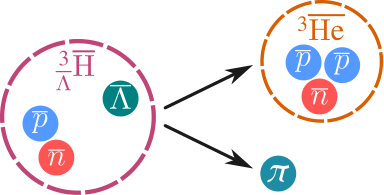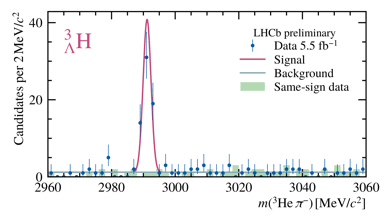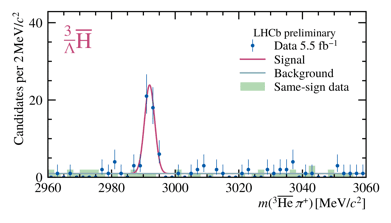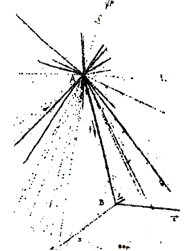Today, at the European Physical Society Conference on High Energy Physics (EPS-HEP), the LHCb Collaboration reported its first observation of hypertritons and antihypertritons using Run 2 data collected between 2016 and 2018. About 100 such hypernuclei were spotted. Hypertritons, 3ΛH, were reconstructed via two-body decays into helium nuclei and pions. The key features of the analysis are the excellent decay reconstruction capabilities of LHCb and a helium identification technique that was applied for the first time beyond the original design of the LHCb detector.
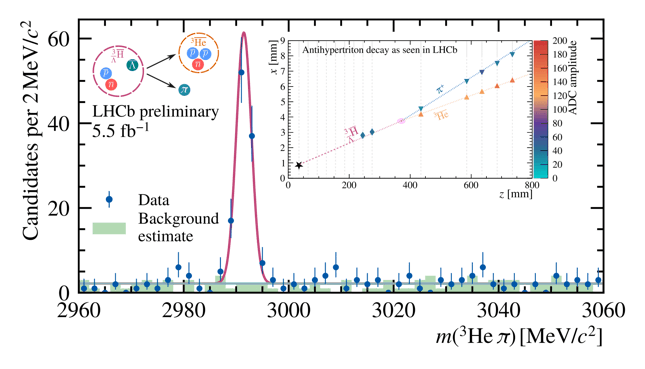
Antihypertriton is similar to the isotope of antihydrogen, known as antitritium, that is composed of an antiproton and two antineutrons bound together by the nuclear force. The key difference is that antihypertriton, as depicted in the image to the left, contains a strange antibaryon, known as the Λ, instead of one of the antineutrons. The basic ingredients of the analysis are presented in the inset image in the plot above showing the production and disintegration of an antihypertriton. The antihypertriton is produced in the LHC proton-proton collisions at the point marked with a black star. After it flies for about 40 cm the Λ hyperon decays via weak interactions into an antiproton p and a pion π+ at the point depicted by the purple ellipse. The pion leaves the nucleus, while the antiproton is captured inside, transforming the antihypertriton into a 3He nucleus composed of two antiprotons and one antineutron. LHCb physicists identify the antihypertritons by calculating the invariant mass of the final products, m(3Heπ+). The reconstruction of hypertriton is identical except that a helium 3He nuclei is used instead of 3He and the charge of the emitted pion is negative. The central peak in the image above represents the sum of observed hypertritons and antihypertritons. A total of 61±8 hypertritons and 46±7 antihypertritons are observed, and their individual mass peaks are shown below.
Helium and antihelium nuclei are doubly charged (two protons or two antiprotons). They are identified by exploiting information from energy losses through ionisation in the VELO, TT and IT silicon trackers. Information from the OT tracker and the RICH detector is used in addition to improve the separation power of heavy-ionising helium and antihelium nuclei from singly charged particles. The colour scale in the inset in the plot at the top of this news article indicates that the amplitude of the VELO response differs for antihypertriton, antihelium and pion tracks.
Hypertritons belong to a class of nuclei called hypernuclei or hyperfragments. The first one was discovered by Danysz and Pniewski in 1952. They found and correctly interpreted the event shown in the image to the left. A cosmic ray interaction in nuclear emulsion caused a nuclear disintegration into many particles among which a nuclear fragment (f) which breaks apart into two long tracks and a short one. The high energy released in the decay and the long lifetime of the fragment f led the authors to postulate that it contained a Λ hyperon, bound into the nucleus. That observation marked the birth of hypernuclear physics that was then studied intensively with cosmic rays in nuclear emulsions and later, in the 1970s, at the CERN PS with counters. Hypertriton production was also observed by the STAR and ALICE collaborations with different experimental techniques.
The helium identification technique used for this analysis is innovative at the LHCb experiment. It proves the feasibility of a rich programme of measurements of quantum chromodynamics and astrophysics interest involving light nuclei. Studying the production of helium and antihelium with collider experiments, such as LHCb, will improve our understanding of the nuclear force, and may also provide information on how such nuclei can be created in space. In addition, hypernuclei such as the hypertriton have significant implication for the understanding of dense astrophysical objects like neutron stars.
Stay tuned for upcoming measurements involving light nuclei at LHCb, and read more in the conference presentation, the conference note, and the forthcoming paper as well in the CERN update.

